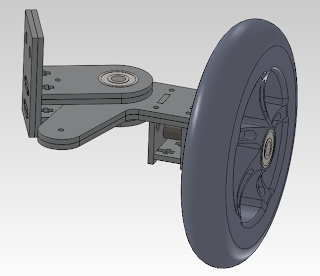 |
| Tommy and Baby glider |
The second glider was our main focus. At five feet long and 60 lbs operating weight (about 45 lbs without ballast), it was tons of fun to bring through TSA... twice. After an hour long private security scan and half a day of travel, everything and everyone made it to Ketchikan safely.
 |
| Bubble wrap + greenie |
 |
| Cleaning up a few of the 3D printed parts with our fancy knives |
We also toured SEAFAC, but weren't allowed to take pictures most of the time, probably for a good reason. The best I could do for photos were a few on the boat ride out and one in their machine shop.
 |
| Biggest lathe I've ever seen |
Lastly, the highlight of the trip happened after we had been given a tour of the mariculture facility and were allowed to test our large glider after showing it to the kids in the SeaGlide program. Gary Freitag was kind enough to let us use his SeaBotix ROV to get footage of the glider in the ocean. It also had a manipulator arm that we could use to grab the glider in case the glider decided it didn't want to come back up. That didn't happen, but the first untethered run was pretty terrifying/awesome anyway.
And so we put the buoyancy engine on a timer, dropped the glider in the ocean, and waited. David was in a kayak and I was piloting the ROV and everyone else was useless. Just kidding, they helped feed the tether off of the 800' spool.
Warning: the awesomeness of the story that follows is not accurately portrayed over the internet. I'm not even going to try.
- Glider put in water
- Glider floats, refuses to sink despite pleas of MRT
- Two washers zip tied to back of glider
- Glider is pretty darn close to perfectly trimmed
- Glider starts dive cycle
- Dive looks good
- People start to remember that there is no tether
- Excitement ensues
- David is alone outside because everyone is inside looking at the ROV screen
- 20' below surface
- 30' below surface - we reached our target depth for the trip!
- Glider still diving
- People start to freak out
- Tom tells Adrian, "DON'T LOSE THE GLIDER. STAY WITH IT"
- Adrian stays with the glider
- 43' below surface
- GLIDER STARTS TO PULL OUT OF DIVE
- GLIDER COMES BACK UP TO THE SURFACE
- EVERYONE IS GOING CRAZY
- WE DID IT! WE DID IT!
- WOOOOOOOOOO
A video of our most glorious moment, accompanied by appropriate music follows. A few notes: the FS at the bottom stands for Feet Seawater, and the CA stands for Camera Angle. This is how we got our depth reading for the glider.
After we pulled the glider out, we got to have some fun with the ROV. Ed ended up stabbing picking up a sea cucumber from 200' and brought it up. When it got to the surface, it was a bit floppy from the pressure change, but fortunately it didn't evacuate its bowels on us, as sea cucumbers are known to do.
 |
| warp speed |
 |
| "It's what's for dinner" |
After returning the sea cucumber to its home and packing up, we merrily feasted on land animals, as seen in the following picture.
 |
| Kodak moment |

























